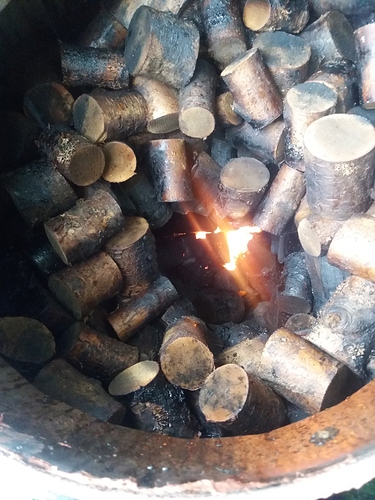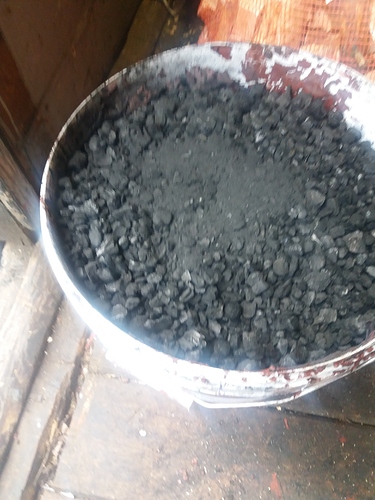Hmm, I get jealous.
Help me understand, are the coal under the nozzles consumed or do they act as a catalyst?
I would say a little bit of both. The heat being the “catalyst” (not really true because heat will be consumed too) for turning CO2 and H2O into CO and H2. But also when pulling oxygene deep into the charcoal, carbon will be consumed and turn to CO.
Maybe converted is more correct.
I’m sure others have better explanations.
Consumed. Super heated H2O and CO2 from the oxidation zone will react with carbon, eat away the charcoal below, looseing heat in the meantime. Nothing catalitical going on at this point.
The catalyst here is actualy ash. Calcium oxide in it does crack tars, and superhot carbon probably does a bit of it too. But mainly the reduction is chemical.
Ok, so I build a new carbon bed all the time?
That I should not have so far between nozzles and restriction, why is that so?
Is it because the heat is allowed to drop, so the gas is regenerated?
All the time. Thats the problem with idleing for too long, charcoal only gets used up in the oxy dation zone and maybee in the restriction, but the reduction only gets “cool” gases wich means its dead and it acts like a filter, collecting dust, makeing a tight charbed.
From that same reason. Idealy, you want your gasifier sized so that the part above the restriction is only oxidative, restriction is the hotest part of all gasifier, then a reduction zone big enaugh to react all the heat, CO2 and H2O to form woodgas but NO LARGER so that the reduction zone doesent produce drag and breaths nicely.
How can restriction be the hottest place?
Hasn’t the reduction of gas already begun above it?
Not idealy. The oxidation zone on a true lmbert is, you culd say, tiny. It is in a way only responcible to burn lots of wood fast in a wery turbolent enviroment. Then concentrate the heat and turbolence in the restriction, thus the heat is highest there. Tars burn and crack. Then enter the reduction zone super hot and tar free.
It was later noticed, with air preheat, longer dwell time etc the oxidation zone can be made much larger. Look at a WK, its nothing but a supersized oxidation zone 
For your engine the sugested oxidation zone for a true Imbert (by Maxs Gasmans formulas is around just 1.5l in volume! You can imagine wood has barely enaugh time to even fully convert to charcoal in such a small but extremely turbolent area.
Anyway, l certainly dont suggest that kind of a lmbert. You have 2 options with woodgas. Go big, slow and cold or small, fast and extremely hot.
My “shoebox” gasifier for my mercedes was the later. Absolutely tiny reaction zone, but so hot inside the ash turned to actual glass. Reactions happened instantly. That tiny thing made a ton of great gas but did not withstand the heat due to some design flaws (thermal stress).
I may seem like l am talking BS here. The other day l told you your gasifier is too small, now l tell you the gasifier needs to be small. Its complicated  each design works but only if you follow some rules and principles. Mix to much and you end with crap.
each design works but only if you follow some rules and principles. Mix to much and you end with crap.
Since you have space its probably beter to go the other way and go big on the gasifier, like a WK. It is simpler to make it last a long time compared to if you go with a small/hot gasifier. Everything suffers there.
Thank you Kristijan for taking the time to answer my questions.
It’s sad that I can’t buy the book from Wayne, so I could see his construction.
Wow, KristijanL.
Finally someone who truly understand the gasifier relationships between T, T, And T biased systems.
And explain this in simple direct terms.
Good I can go to sleep now. I tired easily anymore.
Regards
Steve Unruh
Have been driving the car all week when I look at the sheep, have moved them to where I live in the winter, so that they eat the grass there a little.
Drive about 30km every morning, the car works well but not so good, found a leak yesterday between the unit and the cyclone, so I thought today the car is probably going well, but went worse than usual, feels like it gets too little gas or that there are several leaks.
The coolers get hot on both sides, which they don’t usually get.
But still have problems with bridges, wondering if the wood is still too large, has only birch.
Ha, I suspect your 4.2L engine is pulling pretty hard on that little 9" Imbert 
I think I would experiment with making even smaller fuel. And when you get fed up doing that you may find it less work to build a bigger gasifier 
That was not Hörken you passed, was it?
Went from Hörken towards Yxsjöberg, crossed the road to Sjöändan.
I found a leak today, but no difference.
Has cleaned the cyclone, and hopper, found 10 liters in the cyclone. Wondering if I can have water in the pipes from the filter to the engine, which fails.
No water in the tubes from the filter.
Can the hay in the barrel become dense so fast?
Surely that’s the only thing left?
Did you ever try mixing charcoal with your wood fuel?
Ash/char, I hope?
Remind me - do you still run without a grate? When pulling too hard for too long, eruptions sometimes occur in the reduction and more char than I like slips into the cyclone. I try to always treat my grateless gasifier gently.
Water in a low spot or high water level in the hayfilter creating a bubbler, doesn’t usually affect high end performance much. But you will have a hard time keeping a low idle. Especially letting the pedal up too fast will throw off the a/f mix and stall the engine.
I doubt it. I wash it down with a couple buckets of water only a few times a year and I lose only 1/6 of the vacuum across the filter.
Any wet part of the piping can of course plug with soot but most likely with a plugged system, charbed or grate are responsible.
BUT - since you don’t use vacuum guages and you’re not sure you’re plugged, it can be the other way around. You reported hot rails and a lot of char in the cyclone. Maybe your char is too coarse and you’re pulling oxygene too low.
Ha, you probably realise by now I’m just guessing ![]()
Don, I have not tried to mix in coal in the wood, the car went better before, responded to the gas and reacted to the secondary air better.
Now it seems that I have either too much gas or too little gas, get no good middle position on the air.
JO, I have a roaster now, thought it answered a little better since I cleaned hopper, but it only lasted a little while.
How big should the coal be under restriction, can I have too little coal?
Coal in the cyklonen.
This defenetly looks like you are overdrawing the gasifier. Like JO sayd, grateless gasiiers are prone to eruptians.
That char/ash looks exactly like mine. But when I used a grate on the VW gasifier, I collected only dust in the cyclone as long as I kept cleaning out below the grate. Only when the space below the grate was full, char started to exit into the cyclone.

